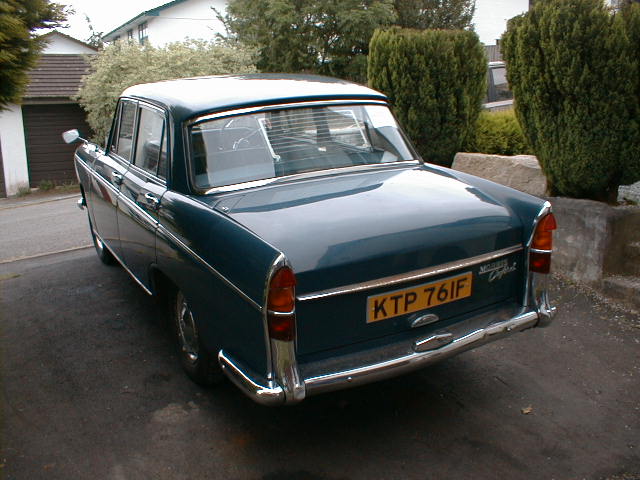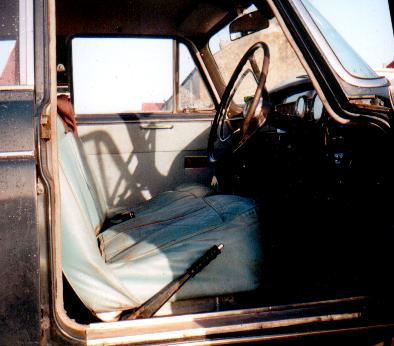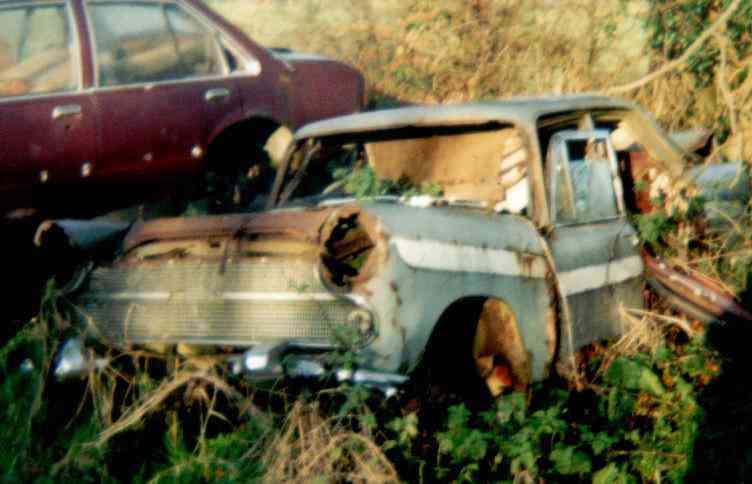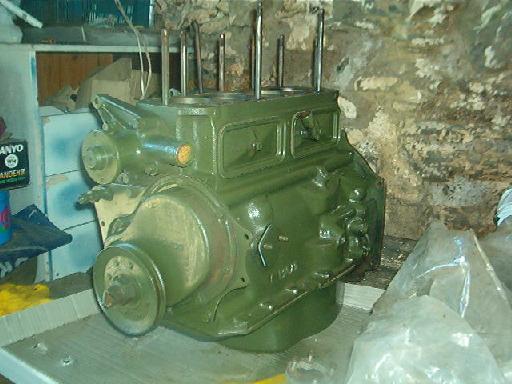My BMC Farina 1622 cc website
by Shane Conway
Last updated on 19 August 2024.
| Email address | Farina history | My Morris Oxford 1999-2005 | My Austin A60 Countryman 2006-2011 | My Austin A60 Saloon 2018 onwards | The first column change Farina | Driving a Wolseley 24/80 |
After parting company with JZE 11 around 1973, 26 years were to pass until another Farina would come into our family. At this time I was running a 1985 Ford Fiesta, and its replacement was becoming necessary due to the planned introduction of the National Car Test (similar to the MoT test in the U. K.) in the Republic of Ireland from January 2000. The Ford was falling victim to the dreaded tin-worm and had a snowball's chance in hell of passing the NCT when its time came up.
My main everyday transport was my company van (then a 1991 Nissan Vanette, later replaced by a 1993 model, and subsequently four Ford Transits in succession), so I required a car for only occasional use. In Ireland all vehicles over 30 years old qualify for a much reduced yearly road tax rate. It was IR£25 in 1999, although with the annual increases and the introduction of the Euro affecting the cost of it, it's still damn cheap!!! Buying a classic was also made more attractive by lower insurance rates, and exemption from the NCT. So I initially settled on wanting an Austin A60 Countryman, but when I started looking for one, there seemed to be none available......
So, enter plan B...... I typed in Morris+Oxford into an Internet search engine one day in July 1999, and up came a site advertising one for sale, namely KTP 761F as seen below. Only snag was I was living in Drogheda, Ireland, and the car was in Gunnislake, Cornwall U.K...........

The above picture (and a few others) accompanied the following description on the site:
Morris Oxford Series 6 1968. Trafalgar Blue. One of the better largely unrestored examples of this fabulous 30 year old car. This has covered approximately 55,000 miles and has had 4 careful owners from new. Its condition is partly due to its having been stored for 15 years of its life until recently. The car benefits from a recent brake overhaul, a new exhaust section and plenty of admiring glances! The car has a current MOT and is of course tax exempt. This genuine example of Britain's motoring heritage is offered for sale for £995.00.
Over the next five months I exchanged several e-mails and phone calls with the seller, with a view to doing an eventual deal for this car. During that time I had to arrange finance to buy it, insurance cover to drive it home, a return flight (optimistic, weren't I?) from Dublin to Bristol, a one way ticket on the ferry from Pembroke to Rosslare, overnight accommodation in Bristol and Rosslare, and check out what was involved in importing a vehicle... Actually buying the car would be the easy part! I read up on various buyers guides about the Farina range, and what sort of things to look out for in the faults department.
So, the big day, December 3rd 1999 dawned. The previous night had been quite stormy, and on getting to Dublin Airport I found the plane was delayed by half an hour. By this time Hugo was already on his way from his home in Cornwall to Bristol Airport where we were to meet up. Between getting off the plane and actually arriving at my front door with the car was to take two days. Having given the car a good once-over and not found anything major to worry about, I drove it around the car park a few times to get the feel of it. Certainly very different to the Vanette or for that matter the Fiesta, both of which I owned at the time. The only fault I could see with the car was a very tatty front bench seat which seemed to be disintegrating..... BUT the car had just passed its MOT a couple of days earlier.......... A plastic container was stuffed below the seat to keep it up, and so I paid the money, signed the forms, and off I went into the Friday evening traffic heading into Bristol city centre, and the overnight accommodation.
Day 2 of the exercise meant an early breakfast and a 9 a. m. start, with a check in time at Pembroke for the Irish Ferries sailing at 2 p. m., 135 miles away. Having filled the tank, I optimistically pushed on, with one occasional eye on the watch. Crossed the Severn Bridge into Wales, and made a stop at Cardiff Gate Services on the M4, where I found the oil level still as it had been the day before, and the radiator needing just a little topping up. Another fault soon showed itself though, it was a very cold day, and the flaming heater (pun not intended) didn't work!!!! So to avoid total hypothermia, on with the extra pair of socks and jumpers....... Anyway, made it into the ferryport at 1.45 p.m., and got on board, parking close to the exit doors. At 7 p. m. or so, KTP 761F drove off the ship, and onto Irish roads for possibly the first time ever. A one-mile drive to a local guesthouse in Rosslare, and KTP was shut down for the night.......
Back on the road on Sunday morning, at 9.30 this time. It seemed even colder now, but at least I was on the final leg of the journey. The journey northwards continued through County Wicklow, along the M11 Bray motorway and into South Dublin. Then the pre-Christmas shopping traffic took its toll and the journey through Ireland's capital was slow. Having negotiated the City Centre, the N2 was selected as the best route option with arrival home just after 3 p. m. At last time to thaw out!!!!! Incidentally on the following weekend the Bristol area suffered a serious freeze-up and impassable roads, so I was glad to have missed that!
2000
The first task was to take the car (in January 2000) to the Vehicle Registration Office in Dundalk to officially import it and get a new Irish registration number for it, and a set of pressed aluminium plates were made up and fitted. KTP 761F was now ZV 3245.
Not long afterwards, ZV 3245 seemed to be having problems starting, or if it could be started, then to actually keep the engine running. So I had the two earth straps and the battery replaced, and removed the petrol tank and cleaned it out. With all that silt and rust removed from the system, the outside of the tank was painted matt black and refitted, and that problem was cured.

The next major job was to tackle that front seat. As seen above the parting between the seat base and the back is just visible. The seat was removed and brought to Jim Hadcock for repair, and it was soon obvious how bad it really was. All except two of the canvas straps inside the seat were either perished or broken, clips rusted and broken, and the covering needed a lot of stitching. And to think I'd driven over 200 miles on that on a freezing cold weekend.... At this point I was really starting to question my sanity!!!! Jim though, did a super job and the finished item was much more comfortable to use, allowing me to see over the steering wheel rather than through it!
Having got it to a reasonably comfortable standard (even if it wasn't in pristine condition), I took it to four classic car events in 2000. Along the way I rummaged through various auto-jumble stands, finding bits and pieces that I either needed or wanted. Spare hubcaps, spare tail lights, an old road test article from 1963, a BMC owner's handbook, and a mid 1960s BMC poster for the Oxford. I also splashed out and bought three more cars as well, but of the 1:43 scale model variety!!!! One full size vehicle is enough at a time!!! Having bought the handbook, I read through it to see how to set the heater controls for some heat. But still to no avail, it was still blowing cold air. Eventually it was narrowed down to being a faulty thermostat, which proved to be totally jammed. Once it was replaced by a new unit, the heat began to flow........
Later in 2000, this almost one ton lump of 1960s British car manufacturing showed just how heavy and under-powered it is by modern standards. I stopped at traffic lights on a steep hill, pulled the handbrake, and NOTHING!!! The cable had snapped off right beside the driver's seat. Luckily there was no traffic behind me as I attempted to get moving again, aided by angling the car back against the pavement. A new cable was promptly purchased from Earlpart in Derbyshire and fitted, as trying to drive around Drogheda without finding a hill is almost impossible!!!
2001
Because of the threat of foot and mouth disease in 2001, events were few and far between. Sadly my Oxford was one of around 22 classic cars from the 1930s to the 1960s which took part in a funeral procession on April 9th 2001, when NEVCC founder member Jim Byrne passed away after a short illness.
I did however take ZV 3245 to the Trim Vintage show in July 2001, where it was photographed alongside a pair of ex Metropolitan Police Wolseleys owned by Ciaran Cavanagh, a 6/99 and a 16/60, which made an interesting contrast. A trip (part holiday, part vintage display) was planned for late August 2001 taking in a vintage display in the village of Grangemockler in County Kilkenny, and over-nighting in the town of Cashel in Co. Tipperary. Prior to that, the car was serviced and I was very lucky in managing to find two crossply tyres of the right size, which I bought and had fitted to replace the worn radial remoulds. The car covered some 350 trouble free miles that particular weekend, and over the few days travelled through seven Irish counties.
2002
Early 2002 saw the acquisition of some body spares (mainly glass and chrome strips) from this sad specimen of a 1965 Cambridge. In fact it was so rotten, that it was possible to literally pull the doors off and take them away for stripping later on. Hard to believe that this wreck was once someone's pride and joy, or a gleaming new car in a mid 1960s showroom, but there you go.... A replacement chrome strip for the bootlid was bought and fitted to replace the rusty and pitted example above the number plate. Louis Woods did some welding on the driver's floor area, and Declan Byrne gave the paintwork a serious polishing.

2003
During early 2003, things were not well under the bonnet of ZV 3245. Firstly a small pipe on the carburettor was discovered to be leaking slightly (just above the exhaust manifold, but fortunately not dripping on to it), so this was replaced with one removed from a scrapped Wolseley. The engine was sounding increasingly rough, and a diagnosis of worn engine bearings was put forward as a possible reason for this. The decision was taken to remove the engine and this was achieved over one weekend in July, with nothing more elaborate than a trolley jack, a set of sockets, a couple of ropes, and some muscle power!!!
The plan was to clean the outer casing of the engine, send the starter motor and dynamo to an auto electrician, and the clutch and pressure plate for reconditioning. The oil was then drained, the cylinder head removed and the engine turned upside down to allow removal of the sump cover. Closer examination of number four piston revealed a right mess, and the potential for a wrecked engine, luckily it was discovered in time. The piston itself had a severe crack in it, as well as worn bearings, but fortunately the other three were okay. Replacement parts were sourced from Earlpart in August with a view to rebuilding the engine during the winter months...... But of course, nothing goes to plan, does it? On refitting the last piston, I managed to break one of the rings!! So, another phone call to Earlpart, and another order for a full set of rings.
2004
Christmas 2003 and New Year 2004 came and went, things settled down at work, and in theory I reasoned on more free time to recommence the assembly process. Well, theory is all very well, but.... Okay, all the bolts, washers and other small parts had been carefully stored on removal, and so were easy enough to refit. For some unknown reason the pistons weren't tightened up until June, followed quickly by the sump case, end plate and flywheel. Only eleven months!!!! Then I decided to respray the engine (in BMC green) and when that was done, the engine bay looked so tatty in comparison that it was added to the list for a repaint.... And then the axle needed to be done as well..... Etc. etc. etc.
Anyway, the engine did look well after a coat of paint, as seen below....

.... even though it was still without the cylinder head, as I thought it would be easier to attach the head after the engine had been re-installed, whenever that would be? Then other matters took my attention, little things like getting married, moving house, that sort of stuff. Plus a mechanic who removed a jammed and worn clutch release bearing informed me that the clutch cylinder seals were perished and needed replacement.
2005
Another Christmas and New Year passed, and again the project seemed to be in limbo. Apart from lousy weather, I also had to move to a new business premises, and had two and a half weeks of doing nothing strenuous after an operation. At this point it was heading for two years since the car had been on the road, and the completion of the project seemed as far away as ever. However, having being impressed by the sight of a freshly re-sprayed Wolseley 16/60, and another enthusiast's acquisition of a low mileage 1963 Riley 4/72, this gave me an incentive to try and get on with working on the Oxford once more. So, an assessment of the car was carried out in May 2005, and a shopping list was drawn up. Among the items obviously needed would be new tyres, brake pipes, rubber bushes for the front suspension, and probably other smaller items not immediately obvious. Two of the wheels which had gone soft were re-inflated, and finally the engine compartment re-spray was finished and the axle done in silver. This may not be original, but it did help to brighten up the underneath of the car, and make any oil spills more obvious in the future.
A further inspection in July 2005 revealed some rot in the sills, and that the exhaust pipe brackets had rusted through, so that the pipe was no longer attached to the car. At this point fate (or sense??) stepped in, and another enthusiast enquired about buying it, so following a few more phone calls, I agreed to sell the car, in its partly restored state. A price was agreed, and ZV 3245 (and its parts) trundled off (on tow) to its new home. So after almost six years in Ireland, the former KTP 761F was with its sixth owner, and I would have hoped it would be back in action a hell of a lot quicker than it would have been under my ownership (two years to rebuild the engine, and not even complete the job in that time). Unfortunately this was not to be the case. Almost three years after the sale took place, very little had been done by the new owner, apart from removing the bonnet and all the seats. Until May 14th 2008 that is, when a drive past its resting place revealed it to have been moved -- three years after that I learnt it was in the owner's backyard, under cover, but still awaiting its turn for restoration. Fast forward to 2020, when I learnt that the person who I sold it to had passed away early in 2019. Whether the car now still exists is unclear, but given the extended time it was lying up, it is very doubtful that it still survives.
Seven years after deciding to buy the Oxford, an Austin A60 Countryman finally became available.
| Email address | Farina history | My Morris Oxford 1999-2005 | My Austin A60 Countryman 2006-2011 | My Austin A60 Saloon 2018 onwards | The first column change Farina | Driving a Wolseley 24/80 |